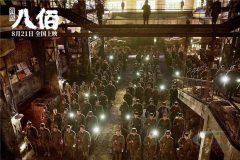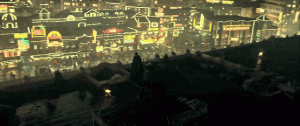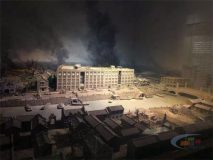THE EIGHT HUNDRED, DIR. GUAN HU (2020)
Sihang Warehouse (Joint Savings Bank Warehouse), Jin An, Shanghai
The Eight Hundred is a film adapted from the famous “Sihang Warehouse Battle” in the history of the Chinese Anti-Japanese War. The film showcases one seemingly unwinnable war of around 420 Chinese soldiers against Japanese aggression 83 years ago. Those Chinese soldiers protected the dignity of our government by holding up well-equipped Japanese invaders from capturing Shanghai with their own flesh and blood.
The 4-day tug-of-war battle took place at a dilapidated warehouse. Sihang Warehouse is a six-story building constructed in 1931 and covered an area of 0.3 hectares. It was the tallest and largest building in Zhabei area at that time. During the war time, it was the last stronghold of the Songhu Battle against Japanese invaders for two reasons: Firstly, Sihang warehouse was originally a joint warehouse of four banks, and its structural integrity was designed to a very high standard. The whole building adopted reinforced concrete frame structure, so it became a perfect fortress for the soldiers to resist enemy tanks and shells. Secondly, Sihang warehouse is on the north bank of Suzhou River, and the British concession was situated just across the river. It is the unique geographical environment that sets back the Japanese’s heavy artillery. Therefore, this design made the warehouse easy to defend and hard to attack, which is helpful for those Chinese soldiers, who were outnumbered and out-equipped by the Japanese force.

Figure1 | Geographical representation of Shanghai’s occupation structure
Dramatic Creation of Building Facades
In the film, the director faithfully restored the building facade on the south of Sihang Warehouse towards the river but made artistic modifications on the north facade. A fortress-like structure in the middle of the north facade adds a sense of industry and war tensions to the building, which gives audience an oppressive feeling of the fierce event that might happen shortly after. In reality, north facade, which isn’t primary orientation of the building, was designed in a rather elegant ArtDeco style.

Figure 2 | The north facade of the warehouse in the film poster
The Illustration of A Large-scale Atrium
Several times in the film, colonel Xie Jinyuan lectured on the second floor of the atrium before the next day’s operation. The sight of soldiers lined up in the atrium below was a heartening scene in the film. However, the actual Sihang Warehouse don’t have such a large atrium. The central corridor of Sihang Warehouse is a slim walkway like any other modern warehouse. The actual width of the atrium is not as large as that in the film, which is about 7 meters. Obviously, such a space is difficult to spread out the heroic battle scenes, and thus the mods were applied by production team to give the interior a military purpose.

Figure 3 | Massive atrium holding meetings in the film

Figure 4 | Actual central corridor of the refurbished warehouse.
The Image of British Concession Across The River
The film tries to make the British concession on the other side of Suzhou River into a miniature of the bustling Shanghai beach, while in reality the actual south bank is all low residential buildings. This film creation is to illustrate a strong contrast of people’s destiny on both side of the river. Rich class citizens, foreign guests, and business men were indifferent to the warfare happening over the river. To them, it was just another entertainment scene, while those soldiers were bathed in bullets and blood, struggling for their life. This showcases the weakness of the Chinese government on the global stage at that time, which further explains the determination of the warriors to defend their country’s dignity.

Clip 1 | The transition from bustling streets to battlefield on the roof of Sihang Warehouse.

Figure 5 | The real buildings over the river
The vandalized walls of the Sihang Warehouse remind us to cherish peace and not to forget the past. In the last scene of The Eight Hundred, the camera rises slowly from the bullet-riddled walls of Sihang Warehouse, and then the time and space gradually switched to the current Shanghai skyline, with rows upon rows of skyscrapers. Today’s prosperous times are made possible by countless brave fighters. Many people didn’t leave their names, but history deserves to be respected and remembered.
— Gaochen WU 3035603992
I appreciate your multidimensional and logical film-set analysis, going through building facades, large-scale atrium, and concession respectively. Meanwhile, the well-matched images of film stills and real scenarios strongly support your comparative analysis. Yet, your report might be more critical and reflective if add some reflection based on the ideas/theories/concepts of the coursework. Besides, where is your reference from? Please specify your reference and figure information.